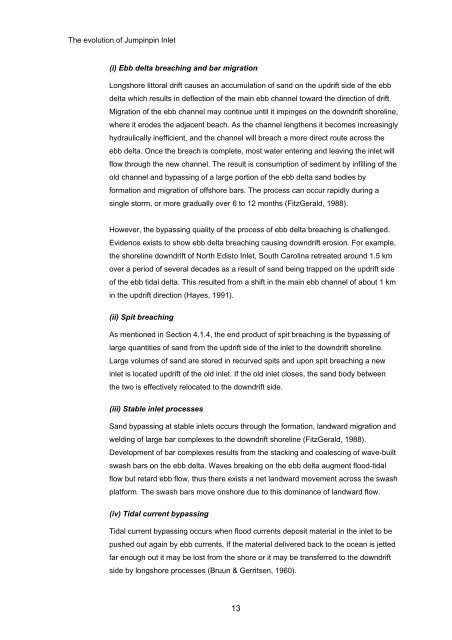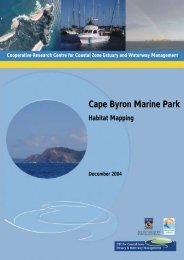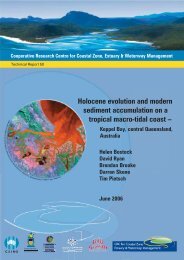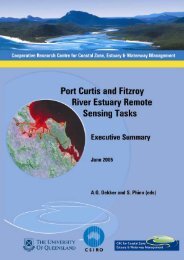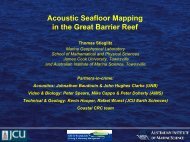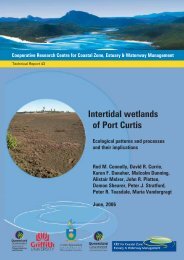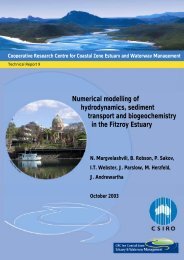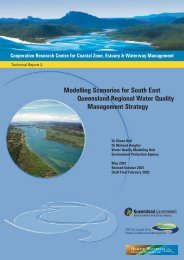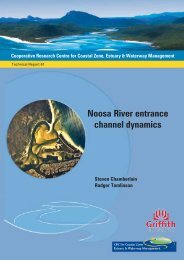The evolution of Jumpinpin Inlet - OzCoasts
The evolution of Jumpinpin Inlet - OzCoasts
The evolution of Jumpinpin Inlet - OzCoasts
Create successful ePaper yourself
Turn your PDF publications into a flip-book with our unique Google optimized e-Paper software.
<strong>The</strong> <strong>evolution</strong> <strong>of</strong> <strong>Jumpinpin</strong> <strong>Inlet</strong><br />
(i) Ebb delta breaching and bar migration<br />
Longshore littoral drift causes an accumulation <strong>of</strong> sand on the updrift side <strong>of</strong> the ebb<br />
delta which results in deflection <strong>of</strong> the main ebb channel toward the direction <strong>of</strong> drift.<br />
Migration <strong>of</strong> the ebb channel may continue until it impinges on the downdrift shoreline,<br />
where it erodes the adjacent beach. As the channel lengthens it becomes increasingly<br />
hydraulically inefficient, and the channel will breach a more direct route across the<br />
ebb delta. Once the breach is complete, most water entering and leaving the inlet will<br />
flow through the new channel. <strong>The</strong> result is consumption <strong>of</strong> sediment by infilling <strong>of</strong> the<br />
old channel and bypassing <strong>of</strong> a large portion <strong>of</strong> the ebb delta sand bodies by<br />
formation and migration <strong>of</strong> <strong>of</strong>fshore bars. <strong>The</strong> process can occur rapidly during a<br />
single storm, or more gradually over 6 to 12 months (FitzGerald, 1988).<br />
However, the bypassing quality <strong>of</strong> the process <strong>of</strong> ebb delta breaching is challenged.<br />
Evidence exists to show ebb delta breaching causing downdrift erosion. For example,<br />
the shoreline downdrift <strong>of</strong> North Edisto <strong>Inlet</strong>, South Carolina retreated around 1.5 km<br />
over a period <strong>of</strong> several decades as a result <strong>of</strong> sand being trapped on the updrift side<br />
<strong>of</strong> the ebb tidal delta. This resulted from a shift in the main ebb channel <strong>of</strong> about 1 km<br />
in the updrift direction (Hayes, 1991).<br />
(ii) Spit breaching<br />
As mentioned in Section 4.1.4, the end product <strong>of</strong> spit breaching is the bypassing <strong>of</strong><br />
large quantities <strong>of</strong> sand from the updrift side <strong>of</strong> the inlet to the downdrift shoreline.<br />
Large volumes <strong>of</strong> sand are stored in recurved spits and upon spit breaching a new<br />
inlet is located updrift <strong>of</strong> the old inlet. If the old inlet closes, the sand body between<br />
the two is effectively relocated to the downdrift side.<br />
(iii) Stable inlet processes<br />
Sand bypassing at stable inlets occurs through the formation, landward migration and<br />
welding <strong>of</strong> large bar complexes to the downdrift shoreline (FitzGerald, 1988).<br />
Development <strong>of</strong> bar complexes results from the stacking and coalescing <strong>of</strong> wave-built<br />
swash bars on the ebb delta. Waves breaking on the ebb delta augment flood-tidal<br />
flow but retard ebb flow, thus there exists a net landward movement across the swash<br />
platform. <strong>The</strong> swash bars move onshore due to this dominance <strong>of</strong> landward flow.<br />
(iv) Tidal current bypassing<br />
Tidal current bypassing occurs when flood currents deposit material in the inlet to be<br />
pushed out again by ebb currents. If the material delivered back to the ocean is jetted<br />
far enough out it may be lost from the shore or it may be transferred to the downdrift<br />
side by longshore processes (Bruun & Gerritsen, 1960).<br />
13


